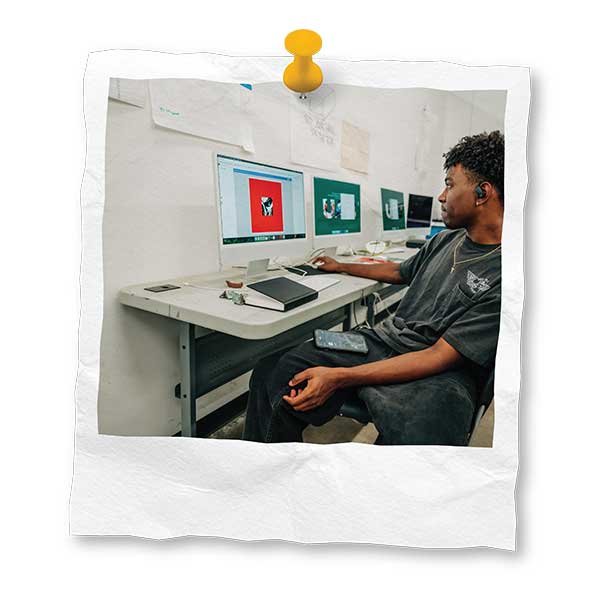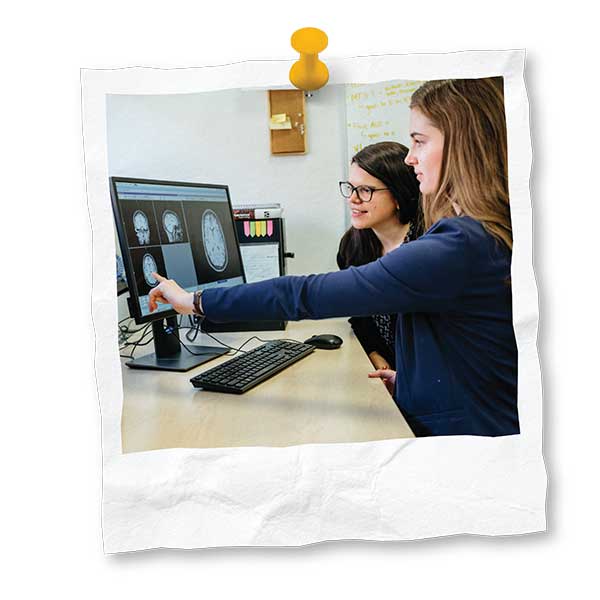
Since the workforce landscape is constantly changing, the College of Arts and Sciences regularly adjusts its offerings as well by adding new majors and degree programs. The goal is to prepare students not only for the jobs of today, but also those of tomorrow.
“The focus of so much development in the College of Arts and Sciences is making sure that our students are active and engaged, and not just passive receptors of material,” says Matthew Pangborn, Ph.D., chair of the Department of English. “That’s the key for them being able to create their own path in the world.”
Here are some new ways that the CAS is helping guide students along that path:
 Graphic and Digital Design
Graphic and Digital Design
Art majors are now able to take their career prospects outside the conventional lines, with the creation of a Graphic and Digital Design concentration. This offering combines traditional graphic design courses with instruction in various forms of multimedia, including photography, videography and animation.
“We have noticed a trend in the commercial arts industry where the people who are getting hired out of college are the ones who have multiple skills,” says Ryan Meyer, assistant professor of Digital Media and Graphic Design in the Department of Art and Art History. “Instead of hiring people for individual tasks, a lot of agencies are prioritizing graduates who have several skillsets, so they can fill in for all these different types of projects wherever they’re needed.
“A strength of this Graphic and Digital Design program is that you get the graphic design skills, plus all the other skills. So even if a student wants to focus on graphic design, they also get to take these other classes and leave UAB with the best possible portfolio.”
 Behavioral Neuroscience
Behavioral Neuroscience
Psychology students no longer need to have a one-track mind when it comes to studying behavioral neuroscience. That’s because in addition to a Ph.D., the Department of Psychology now offers a master’s degree in behavioral neuroscience.
“This program fills that in-between niche, where bachelor’s students can receive a graduate education and then go ahead and enter the workforce without getting a Ph.D,” says professor David Knight, Ph.D., director of the Behavioral Neuroscience Graduate Program.
Knight says that by providing this master’s option, bachelor’s graduates from other fields who are still unsure of their career choice can try neuroscience without making the time commitment needed for a Ph.D. It also allows students who might eventually want to purse a Ph.D to receive valuable research experience.
“Sometimes it’s difficult for undergraduate students to engage in the type of research needed to be competitive for a Ph.D. program,” Knight says. “Our master’s program provides an opportunity for them to get that experience. So it can lead students to both a future career, and to future educational training.”
Music Therapy
It is not uncommon for Alzheimer’s patients who don’t remember their own name to flawlessly recall every word to a favorite song from their childhood. Such is the power of music.
Because of these curative benefits, UAB Hospital has operated a music therapy program through UAB Medicine since 1999. Now the Department of Music is striking a similar chord with the establishment of a music therapy concentration.
“Music therapy is an established health profession in which music is used within a therapeutic relationship to address physical, emotional or social needs of individuals,” says program director Ja’Bria Barber, Ph.D. “We offer students comprehensive ways to approach music therapy.”
The curriculum for the program prepares students to earn the Music Therapist-Board Certified (MT-BC) credential required to practice in the field. Students also are able to receive hands-on experience by working with health professionals at UAB.
“Even though this academic program is new, the music therapy infrastructure is already here,” Barber says. “So there are opportunities in place for collaboration and for students to be part of interdisciplinary teams.”

Human Rights
Every student at UAB, regardless of their educational interest, has one thing in common. They are all humans. That is why the new Human Rights degree can be useful in almost any professional field, according to UAB professor Tina Kempin Reuter, Ph.D., director of the Institute for Human Rights.
“This degree is customizable to what the student is interested in and the things that might help their professional development,” Reuter says. “It can help students going into a variety of careers: government, non-profits, public administration, education. Even pre-med students. Because human rights has a lot to do with interactions with other people, which is an important part of medical training.”
In addition to classroom work, Reuter says there is an important service-learning component to the degree, including an internship in conjunction with the Birmingham Immersive Community Empowerment Program (BICEP).
“Students get paired up with organizations throughout Birmingham and do a nine-month internship with them,” Reuter says. “The idea is to get the students hands-on skills, so they can jump into this work once they get their degree.”

Writing and Media
After decades of relative stability, both the act of writing and the media entities where writing is featured have gone through drastic upheavals recently. The new Writing & Media major in the Department of English is designed to keep students at the forefront of these developments.
“There is so much rapid change happening in the ways we’re communicating with one another,” Pangborn says. “Writing happens across a lot of different disciplines now, and each area has its own ways of communicating. When you change the source, you’re also changing the way the message is produced.”
Since there are so many different options, from manuscripts to memes, Pangborn says the major “can be shaped” to reflect a student’s primary areas of interest. But no matter what direction the student takes, Pangborn says the most important aspect of the major is the writing itself.
“It’s extremely writing intensive, which is helpful to students,” Pangborn says. “You can read about writing all you want. But when you have to get those words out, that’s when the learning really happens.”


